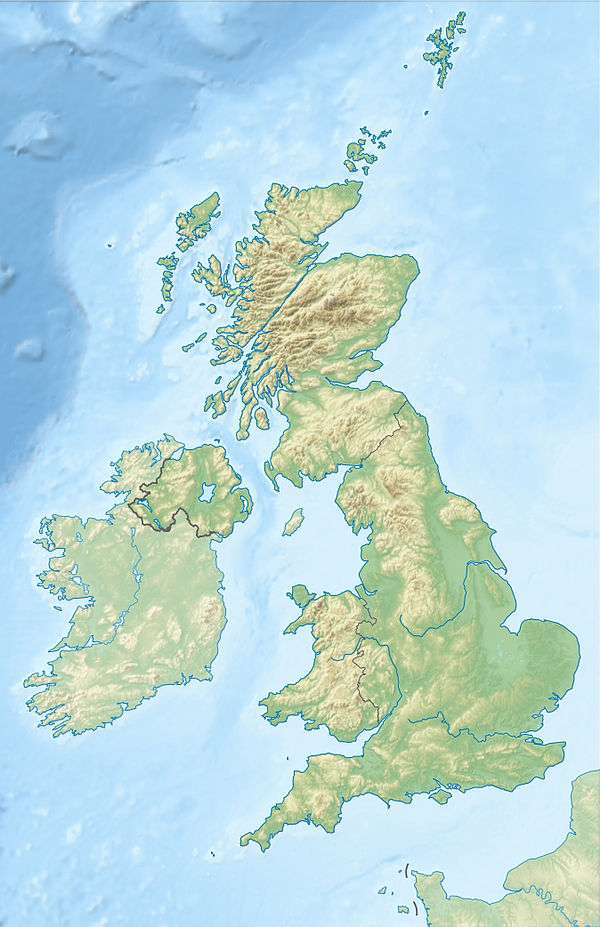Army Air Corps (United Kingdom)
The Army Air Corps (AAC) is a component of the British Army, first formed in 1942 during the Second World War by grouping the various airborne units of the British Army (which are no longer part of the AAC). Today, there are eight regiments (seven Regular Army and one Reserve) of the AAC as well as four Independent Flights and two Independent Squadrons deployed in support of British Army operations across the world. They are located in Britain, Brunei, Canada, and Germany. Some AAC squadrons provide the air assault elements of 16 Air Assault Brigade through Joint Helicopter Command.
| Army Air Corps | |
|---|---|
 Cap Badge of the Army Air Corps. | |
| Active | 1942–1949 1957–present |
| Country | |
| Branch | |
| Type | Army aviation |
| Role | Battlefield support, reconnaissance |
| Size | 2,000 personnel Approx. 200 aircraft[1] |
| Garrison/HQ | 1 Regiment: Yeovilton 2 Regiment: Middle Wallop 3 Regiment: Wattisham 4 Regiment: Wattisham 5 Regiment: Aldergrove 6 Regiment: Army Reserve 7 Regiment: Middle Wallop |
| March | Quick: Recce Flight Slow: Thieving Magpie |
| Battle honours | Falkland Islands 1982 Wadi al Batin, Gulf 1991 Basra, Iraq 2003 |
| Commanders | |
| Colonel-in-Chief | HRH The Prince of Wales |
| Colonel of the Regiment | General The Rt Hon. The Lord Dannatt KCB CBE MC |
| Insignia | |
| Tactical Recognition Flash |  |
| Aircraft flown | |
| Attack | Apache AH1 |
| Reconnaissance | Gazelle AH1 Wildcat AH1 |
| Trainer | Jupiter HT1 Juno HT1 |
| Transport | 212HP AS365N3 Dauphin II |
History
.png) |
| British Army of the British Armed Forces |
|---|
| Components |
|
| Administration |
| Overseas |
| Personnel |
|
| Equipment |
| History |
| United Kingdom portal |
First formation: 1942–1949
The British Army first took to the sky during the 19th century with the use of observation balloons.[2] In 1911 the Air Battalion of the Royal Engineers was the first heavier-than-air British military aviation unit.[3] The following year, the battalion was expanded into the Military Wing of the Royal Flying Corps which saw action throughout most of the First World War until 1 April 1918, when it was merged with the Royal Naval Air Service to form the Royal Air Force.[4]
Between the wars, the army used RAF co-operation squadrons.[5]
At the beginning of the Second World War, Royal Artillery officers, with the assistance of RAF technicians, flew Auster observation aircraft under RAF-owned Air Observation Post (AOP) Squadrons. Twelve such squadrons were raised —three of which belonged to the RCAF— and each performed vital duties in a wide array of missions in many theatres.[6][7][8]
Early in the war, Winston Churchill announced the establishment of a new branch of army aviation, the Army Air Corps, formed in 1942. The corps initially comprised the Glider Pilot Regiment and the Parachute Battalions (subsequently the Parachute Regiment), Air Landing Regiments, and the Air Observation Post Squadrons. In March 1944, the SAS Regiment was added to the corps.[9]
One of their most successful exploits during the war was Operation Deadstick, including the attack on Pegasus Bridge, which occurred on 6 June 1944, prior to the landings on Normandy. Once the three gliders landed, some roughly which incurred casualties, the pilots joined the glider-borne troops (Ox & Bucks Light Infantry) to act as infantry. The bridge was taken within ten minutes of the battle commencing and the men there withstood numerous attempts by the Germans to re-capture the location. They were soon reinforced and relieved by soldiers from Lord Lovat's 1 Special Service Brigade.[10]
The AAC was broken up in 1949, with the SAS returning to its independent status, while the Parachute Regiment and Glider Pilot Regiment came under the umbrella of the Glider Pilot and Parachute Corps.[9]
Second formation: 1957–present
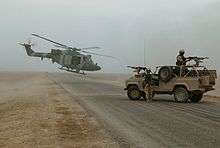
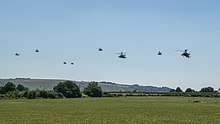
In 1957 the Glider Pilot and Parachute Corps was split, with the Parachute Regiment becoming an independent formation, while the Glider Pilot Regiment was merged with the Air Observation Squadrons of the Royal Artillery into a new unit, the Army Air Corps.[11]
From 1970, nearly every army brigade had at least one Aviation Squadron that usually numbered twelve aircraft. The main rotor aircraft during the 1970s were the Westland Scout and Bell Sioux general purpose helicopters. The Sioux was replaced from 1973 by the Westland Gazelle used for Airborne reconnaissance;[12] initially unarmed, they were converted to carry 68mm SNEB rocket pods in 1982, during the Falklands War. The Scout was replaced from 1978 by the Westland Lynx, which was capable of carrying additional firepower in the form of door gunners.[13]
Basic rotary flying training was carried out on the Sioux in the 1970s, on the Gazelle in the 1980s and 1990s, and is currently conducted on the Eurocopter H145 through the Defence Helicopter Flying School.[14]
Fixed-wing types in AAC service have included the Auster AOP.6 and AOP.9 and DHC-2 Beaver AL.1 in observation and liaison roles. In 1989, the AAC commenced operating a number of Britten-Norman Islander aircraft for surveillance and light transport duties.[15] The corps operated the DHC-1 Chipmunk T.10 in a training role until its replacement by the Slingsby T67 Firefly in the 1990s. The Firefly was replaced by the Grob Tutor in 2010.[16]
Cold War
During the Cold War the majority of Army Air Corps units were based in Germany and part of the British Army of the Rhine. At the beginning of 1989 the Army Air Corps structure was as follows:[17][18][19][20]
- Army Air Corps, AAC Middle Wallop
- 1 Wing AAC, Hobart Barracks in Detmold, West Germany, under operational control of Commander Aviation 1st British Corps (Wing disbanded during 1989)
- 1 Regiment AAC, Tofrek Barracks in Hildesheim, supported 1st Armoured Division
- 651 Squadron AAC, (Anti-Tank, 4x Gazelle AH.1, 12x Lynx AH.7 (TOW))
- 652 Squadron AAC, (Anti-Tank, 4x Gazelle AH.1, 12x Lynx AH.7 (TOW))
- 661 Squadron AAC, (Reconnaissance, 12x Gazelle AH.1)
- 3 Regiment AAC, Salamanca Barracks in Soest, supported 3rd Armoured Division
- 653 Squadron AAC, (Anti-Tank, 4x Gazelle AH.1, 12x Lynx AH.7 (TOW))
- 662 Squadron AAC, (Reconnaissance, 12x Gazelle AH.1)
- 663 Squadron AAC, (Reconnaissance, 12x Gazelle AH.1)
- 4 Regiment AAC, Hobart Barracks in Detmold, supported 4th Armoured Division
- 654 Squadron AAC, (Anti-Tank, 4x Gazelle AH.1, 12x Lynx AH.7 (TOW))
- 659 Squadron AAC, (Anti-Tank, 4x Gazelle AH.1, 12x Lynx AH.7 (TOW))
- 669 Squadron AAC, (Reconnaissance, 12x Gazelle AH.1)
- 1 Regiment AAC, Tofrek Barracks in Hildesheim, supported 1st Armoured Division
- 2 Wing AAC, AAC Netheravon (Wing disbanded during 1989)
- Northern Ireland Regiment AAC, AAC Aldergrove (Later renamed 5 Regiment AAC)
- 655 Squadron AAC, AAC Ballykelly, (Anti-Tank, 4x Gazelle AH.1, 12x Lynx AH.7), supported 2nd Infantry Division
- 665 Squadron AAC, (16x Gazelle AH.1), supported HQ Northern Ireland
- 1 Flight AAC, (Reconnaissance, 4x DHC-2 Beaver AOP)
- 7 Regiment AAC, AAC Netheravon
- 656 Squadron AAC, (Anti-Tank, 4x Gazelle AH.1, 12x Lynx AH.7), supported 1st Infantry Brigade
- 666 Squadron AAC (V), (Territorial Army, Home Defence, 12x Gazelle AH.1)
- 2 Flight AAC, (4x Gazelle AH.1), supported NATO's AMF(L)
- 657 Squadron AAC, Colchester Garrison, (Anti-Tank, 4x Gazelle AH.1, 12x Lynx AH.7), supported 9th Infantry Brigade; joined 9 Regiment AAC in July 1990.
- Northern Ireland Regiment AAC, AAC Aldergrove (Later renamed 5 Regiment AAC)
- 9 Regiment AAC, RAF Topcliffe, part of 24th Airmobile Brigade
- 672 Squadron AAC, (Lynx Light Battlefield Helicopter Squadron, activated 1 January 1990, 12x Lynx AH.9)
- 3 Flight AAC, (4x Gazelle AH.1)
- School of Army Aviation, AAC Middle Wallop
- 670 Squadron AAC, Middle Wallop, (Operational Training, 12x Gazelle AH.1, activated 1989)
- 671 Squadron AAC, Middle Wallop, (Conversion to Type, 8x Gazelle AH.1, 8x Lynx AH.7)
- Trade Training School (Ground Crew & Maintenance Training)
- 660 Squadron AAC, RAF Sek Kong, Hong Kong, (12x Scout AH.1), supported British Forces Hong Kong, two Scouts detached to British Forces Brunei
- C Flight, 660 Squadron AAC, Anduki Airfield in Seria, Brunei, (2x Scout AH.1)
- 664 Squadron AAC, St George's Barracks in Minden, West Germany, (Reconnaissance, 12x Gazelle AH.1), supported 1st British Corps
- Development & Trials Squadron, AAC Middle Wallop, (12x Gazelle AH.1, under Director Army Air Corps. On 1 April 1990 renamed 667 (D&T) Squadron AAC)
- 7 Flight AAC, RAF Gatow, Berlin, (4x Gazelle AH.1), supported the Berlin Infantry Brigade
- 8 Flight AAC, Stirling Lines, Hereford, (4x A109A Hirundo), supported the Special Air Service
- 12 Flight AAC, RAF Wildenrath, Germany, (4x Gazelle AH.1), supported British Army of the Rhine
- 16 Flight AAC, Kingsfield Airfield in Dhekelia, Cyprus, (4x Gazelle AH.1) supported British Forces Cyprus
- 25 Flight AAC, Price Barracks, Belize, (4x Gazelle AH.1), supported British Army Training and Support Unit Belize
- 29 (BATUS) Flight AAC, CFB Suffield, Canada, (4x Gazelle AH.1), supported British Army Training Unit Suffield
- UNFICYP Flight AAC, Nicosia Airport, Cyprus, (4x Gazelle AH.1), supported United Nations Peacekeeping Force in Cyprus
- 1 Wing AAC, Hobart Barracks in Detmold, West Germany, under operational control of Commander Aviation 1st British Corps (Wing disbanded during 1989)
War on Terror
A further boost in the Army Air Corps' capability came in the form of the Westland Apache AH.1 attack helicopter. In 2006, British Apaches deployed to Afghanistan as part of the NATO International Security Assistance Force. In 2004, Britten-Norman Defender fixed wing aircraft were purchased for Afghanistan and Iraq.[15]
Current structure and deployment
Mascot
The Army Air Corps adopted their first Corps Mascot: Zephyr, a bald eagle, in October 2011[21]
Training
The training of future Army Air Corps aircrew is delivered by the joint service UK Military Flying Training System. Elementary Flying Training is delivered at RAF Barkston Heath, alongside Royal Navy students.
Training Units, Middle Wallop
- 7 (Training) Regiment AAC
- 670 Squadron – Operational Training
- 671 Squadron – 'Lynx/Gazelle/Bell 212'j (Future uncertain, given retirement of Gazelle and Lynx fleets)
- 673 Squadron – Apache Conversion to type
- Defence Elementary Flying Training School, RAF Barkston Heath | Prefect T1[22]
- Defence Helicopter Flying School, RAF Shawbury | Squirrel HT.1
- 660 Squadron
Personnel

The strength of the Army Air Corps is about 2,000 Regular personnel, of which 500 are officers. However, the AAC draws an additional 2,600 personnel from the Royal Logistic Corps, the Royal Electrical and Mechanical Engineers and the Adjutant General Corps.[23] Therefore, total related Army Air Corps personnel is around 4,600.[24]
Aircraft
As of 2019, the AAC solely operates rotary-wing aircraft in the operational environment. The AAC uses the same designation system for aircraft as the Royal Air Force and the Fleet Air Arm. Fixed-wing training aircraft include the Grob Tutor for Army Flying Grading and the Grob Prefect (for Elementary Flying Training by No. 674 Squadron Army Air Corps).[25][26]
Today AAC aviators fly four types of helicopter, and within each type there are usually several marks/variants which carry out different roles. Pilots train with No. 1 Flying Training School[27] at RAF Shawbury. The School is a tri-Service organisation consisting of civilian and military instructors that take the student from basic flying through to more advanced flying such as instrument flying, navigation, formation flying and captaincy. In service aircraft include: the Bell 212HP AH1,[28] the Eurocopter AS365N3 Dauphin II,[29] the Airbus Helicopters H135 Juno,[26] the Westland Gazelle AH1,[30] the Westland Wildcat AH.1[31] and the AgustaWestland Apache AH1.[32]
Transfer of Fixed-Wing assets
In April 2019, the Army transferred the AAC’s Islander and Defender aircraft operated by 651 Squadron from 5 Regiment to No. 1 Group Royal Air Force. The aircraft will be operated by RAF personnel, replacing Army personnel through attrition.[33]
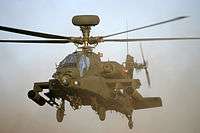
.jpg) Britten-Norman Islander AL.1
Britten-Norman Islander AL.1.jpg)
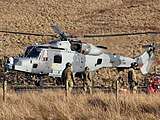

.jpg)
Command & units
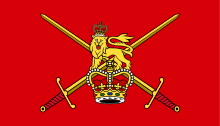 |
| Arms of the British Army |
|---|
| Combat Arms |
|
|
| Combat Support Arms |
|
| Combat Services |
|
|
The AAC regiments will be consolidated into the following structure:[34]
Aviation Reconnaissance Force
- 1 Regiment AAC, RNAS Yeovilton | Wildcat AH.1
- 659 Squadron
- 661 Squadron
- 652 Squadron (OCU)
- 5 Regiment AAC, Aldergrove | Gazelle
- 651 Squadron - aircraft transferred to RAF April 2019[33]
- 665 Squadron
- 1 Regiment AAC, RNAS Yeovilton | Wildcat AH.1
Wattisham Flying Station Headquarters (WFS HQ), formerly the Attack Helicopter Force (AHF) (Supporting 3rd (UK) Division, 16 Air Assault Brigade and Royal Marines) Wattisham | Apache AH.1 [38]
- 3 Regiment AAC
- 662 Squadron
- 663 Squadron
- 653 Squadron (OCU)
- 4 Regiment AAC
- 656 Squadron
- 664 Squadron
- 3 Regiment AAC
Army Reserves[39]
- 6 Regiment AAC
- RHQ/HQ Squadron, Bury St. Edmunds
- 675 Squadron, Taunton/Yeovil
- 677 Squadron, Bury St. Edmunds
- 678 Squadron, Milton Keynes/Luton
- 679 Squadron, Portsmouth/Middle Wallop
- Aviation Specialist Group, Middle Wallop
- 6 Regiment AAC
Joint Special Forces Aviation Wing
- Stirling Lines | Dauphin II/Gazelle AH.1
- 658 Squadron
1 and 9 Regt AAC will merge under one headquarters (1 Regt AAC) and re-locate to RNAS Yeovilton to form a large regiment equipped with the new AgustaWestland Wildcat helicopter. The Regular component of Army Air Corps capability will consist of two regular aviation regiments equipped with Apache, one large regular aviation regiment equipped with Wildcat, and one regular manned aerial surveillance regiment,[40] although the Gazelle out-of-service date is currently 2018 and it has not yet been confirmed whether or how the capability will be replaced.[41] All five squadrons from 1 and 9 AAC will remain. Four squadrons will be the front line Lynx Wildcat squadrons, one (652 Squadron) will become the Wildcat Operational Conversion Squadron.[42]
There will be two frontline squadrons of Apache helicopters in both 3 and 4 Regiment AAC, with 3 Regiment also parenting the Apache OCU, 653 Squadron. One Regiment will be at high readiness at any one time. One of the squadrons will be attached to HMS Ocean and/or the new Queen Elizabeth-class aircraft carriers for expeditionary operations. Another will be attached to the lead armoured battlegroup.[43] However, under Army 2020 Refine, 3 Regiment AAC will be tasked to support the armoured infantry, and strike brigades of 3 (UK) Division and 4 Regiment AAC will support the army's 16 Air Assault Brigade and 3 Commando Brigade of the Royal Marines.[44]
5 Regiment may be disbanded following the future retirement of the Gazelle fleet operated by 665 Squadron and also as a consequence of the transfer in 2019 of the Defender and Islander operated by 651 Squadron to the RAF.[33]
Independent units
- 7 Flight (British Forces Brunei)
- 660 Squadron (part of the Defence Helicopter Flying School)
- 667 (Development and Trials) Squadron
- 674 Squadron (No. 1 Flying Training School)[45]
- Army Flying Grading
- Army Historic Aircraft Flight
- The Army Air Corps Blue Eagles Display Team
- The Army Air Corps Parachute Display Team
No. 651 Squadron personnel part of No. 1 Group RAF based at JHC FS Aldergrove.[33][46]
Battle honours
The Army Air Corps is classed, in UK military parlance, as a "Combat Arm". It, therefore, carries its own guidon and is awarded battle honours. The honours awarded to the AAC are:
- Normandy Landings 1944
- Merville Battery 1944
- Rhine 1945
- North West Europe 1944 – 45
- Sicily 1943
- Pegasus Bridge
- Arnhem 1944
- Southern France
- Falkland Islands 1982
- Wadi al Batin 1991
- Gulf 1991
- Al-Basrah
- Iraq 2003
Alliances
.svg.png)
.svg.png)
Order of precedence
| Preceded by Special Air Service |
British Army Order of Precedence | Succeeded by Special Reconnaissance Regiment |
See also
- List of airfields of the Army Air Corps
- Museum of Army Flying
- List of Army Air Corps aircraft squadrons
- Joint Helicopter Command
- Army aviation
- List of air forces
References
- "World Air Forces" (PDF). Flight International. 2014. Archived (PDF) from the original on 26 October 2018. Retrieved 25 August 2014.
- Farrar-Hockley 1994, p. 9.
- Farrar-Hockley 1994, p. 17.
- Farrar-Hockley 1994, p. 41.
- Rawlings 1984, pp. 255–259.
- Rawlings 1984, p. 259.
- Halley 1988, pp. 444–451.
- Jefford 2001, pp. 102–105.
- "Army Air Corps". National Army Museum. Retrieved 16 May 2020.
- Ambrose, Stephen E. (1994). D-Day. New York: Simon & Schuster. ISBN 978-1476765860..
- Farrar-Hockley 1994, pp.179, 187–194.
- "Gazelle – British Army Website". Army.mod.uk. Archived from the original on 10 April 2017. Retrieved 27 September 2016.
- "Profile of a UK forces' mainstay." Archived 23 December 2006 at the Wayback Machine BBC News, 9 September 2004.
- "Contractors". RAF Shawbury. Archived from the original on 1 June 2008. Retrieved 19 July 2018.
- Ripley, Tim (14 September 2016). "UK MoD looks to transfer Army Defender and Islander aircraft to RAF". Jane's Defence Weekly. Archived from the original on 13 August 2017.
- "Grob G 115". Skybary. Retrieved 16 May 2020.
- "Royal Army Service Corps". British Army units 1945 on. Archived from the original on 5 June 2017. Retrieved 2 July 2017.
- "Army Air Corps". Helis. Archived from the original on 3 August 2017. Retrieved 2 July 2017.
- "BAOR Order of Battle July 1989" (PDF). Louis Vieuxbill. Archived (PDF) from the original on 14 September 2016. Retrieved 2 July 2017.
- "Aviation". Ministry of Defence. Archived from the original on 16 June 2017. Retrieved 2 July 2017.
- "Zephyr – the Army Air Corps mascot". Ministry of Defence. Archived from the original on 21 June 2017. Retrieved 16 July 2017.
- "First student prefect sortie". Retrieved 25 May 2020.
- "Adjutant General's Corps". army.mod.uk. Retrieved 27 May 2020.
- THE ARMY AIR CORPS (AAC) Archived 1 February 2014 at the Wayback Machine, armedforces.co.uk
- "Royal Air Force Grob Tutor". Royal International Air Tattoo. Archived from the original on 19 September 2018. Retrieved 18 September 2018.
- "Royal Air Force". Royal Air Force. Archived from the original on 10 September 2017. Retrieved 5 January 2020.
- "RAF chief opens state-of-the-art helicopter training facilities in Shawbury".
- "Bell 212 – British Army Website". Army.mod.uk. Archived from the original on 23 January 2014. Retrieved 27 September 2016.
- "Photos: Eurocopter AS-365N-3 Dauphin 2 Aircraft Pictures". Airliners.net. 20 November 2008. Archived from the original on 30 July 2010. Retrieved 11 May 2014.
- "Gazelle". mod.uk. Archived from the original on 13 March 2008. Retrieved 7 August 2016.
- "Westland Wildcat". mod.uk. Archived from the original on 13 March 2008. Retrieved 7 August 2016.
- "Attack Helicopter". mod.uk. Archived from the original on 13 March 2008. Retrieved 7 August 2016.
- Jennings, Gareth (2 April 2019). "UK transfers Defender and Islander special mission aircraft from AAC to RAF". Jane's Defence Weekly. Retrieved 23 February 2020.
- Army 2020 Archived 18 April 2013 at the Wayback Machine
- "The Eagle Spring 2020 edition" (PDF). The Eagle. Wattisham. 1 April 2020. Retrieved 6 May 2020.
- Ripley, Tim (6 April 2020). "UK forms aviation brigade". IHS Janes. Retrieved 6 May 2020.
- "Army establishes its 1st Aviation Brigade". British Army. 5 May 2020. Retrieved 6 May 2020.
- "The Eagle Spring 2020 edition" (PDF). The Eagle. Wattisham. 1 April 2020. Retrieved 8 May 2020.
- "Army 2020 Reserve Structure & Basing" (PDF). Archived (PDF) from the original on 22 July 2017. Retrieved 30 May 2015.
- "Army to reduce by 23 units – British Army Website". Army.mod.uk. 5 July 2012. Archived from the original on 22 May 2013. Retrieved 11 May 2014.
- "Army Air Corps future structure". UK Armed Forces Commentary. Archived from the original on 30 May 2015. Retrieved 30 May 2015.
- Tim Ripley, London – IHS Jane's Defence Weekly (13 October 2013). "British Army helicopters leave Germany – IHS Jane's 360". Janes.com. Archived from the original on 6 October 2014. Retrieved 11 May 2014.
- Anonymous (8 July 2014). "654 Squadron's Last Parade Before Disbandment". forces.tv. Archived from the original on 6 March 2016. Retrieved 7 August 2016.
- Ripley, Tim (9 February 2017). "UK re-roles Apache attack helicopter units". IHS Janes. Archived from the original on 13 August 2017. Retrieved 13 August 2017.
- "https://www.shropshirestar.com/news/local-hubs/north-shropshire/shawbury/2020/02/29/raf-chief-opens-state-of-the-art-helicopter-training-facilities-in-shawbury/". External link in
|title=(help) - "651 Squadron Army Air Corps". British Army. Archived from the original on 4 June 2017.
Bibliography
- Farrar-Hockley, General Sir Anthony. The Army in the Air: The History of the Artmy Air Corps. Stroud, Gloucestershire, UK: Alan Sutton Publishing Ltd., 1994. ISBN 0-7509-0617-0.
- Halley, James J. The Squadrons of the Royal Air Force & Commonwealth 1918–1988. Tonbridge, Kent, UK: Air Britain (Historians) Ltd., 1988. ISBN 0-85130-164-9.
- Jefford, C.G. RAF Squadrons, a Comprehensive record of the Movement and Equipment of all RAF Squadrons and their Antecedents since 1912. Shrewsbury, Shropshire, UK: Airlife Publishing, 1988 (second edition 2001). ISBN 1-85310-053-6.
- Mead, Peter. Soldiers in the Air: The Development of Army Flying. London: Ian Allan Ltd., 1967. OCLC 464211829
- Parham Major General H.J. & Belfield E.M.G. Unarmed into Battle: The Story of the Air Observation Post. Warren & son, for the Air O.P. Officers' Association, Winchester, 1956. (Second edition: Chippenham, Wiltshire, UK: Picton Publishing Ltd., 1986. ISBN 978-0-948251-14-6)
- Rawlings, John D.R. Coastal, Support and Special Squadrons of the RAF and their Aircraft. London: Jane's Publishing Company Ltd., 1982. ISBN 0-7106-0187-5.
External links
| Wikimedia Commons has media related to Army Air Corps (UK). |
- Official website

- School of Army Aviation
- Army Air Corps Historic Aircraft Flight official webpage
- The Blue Eagles – Army Air Corps Helicopter Display Team official webpage
- The Silver Eagles – Army Air Corps Freefall Parachute Display Team official webpage
- Army Air Corps group pool of images on Flickr
- Army Air Corps in Germany private webpage
